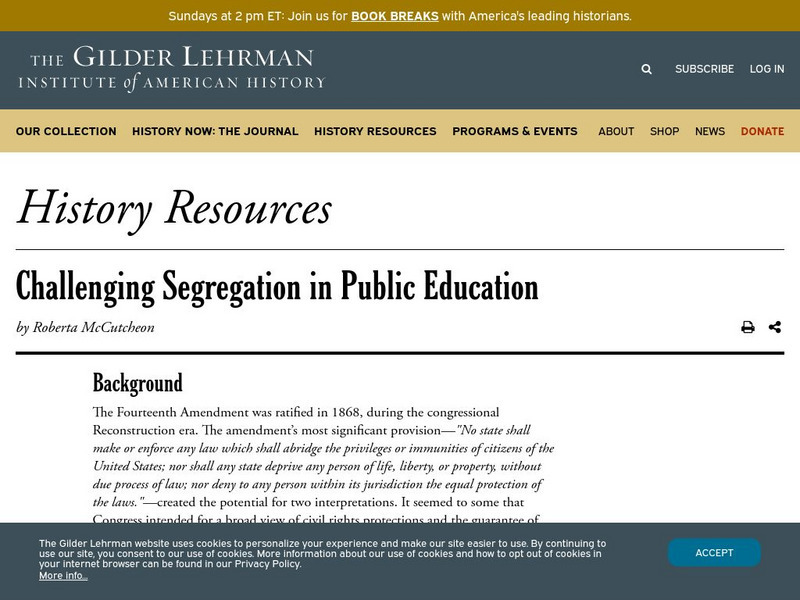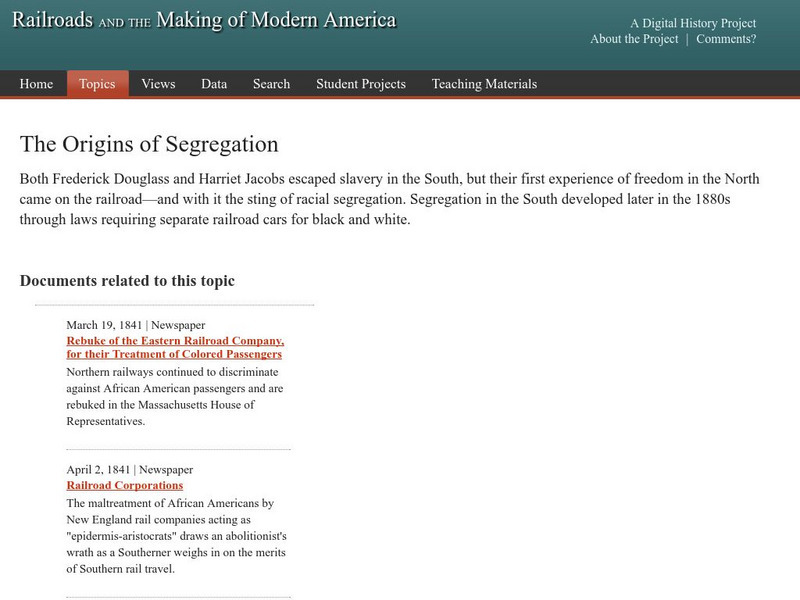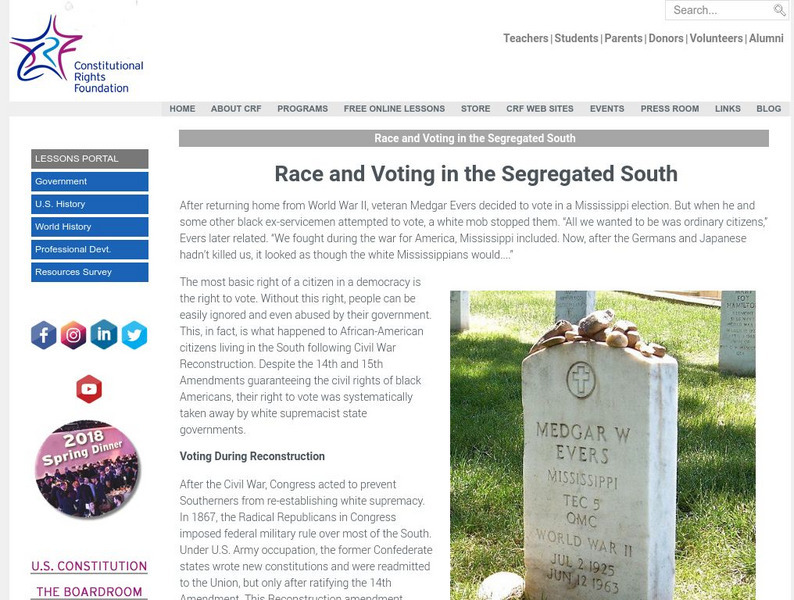Hi, what do you want to do?
Curated OER
Tobacco: Relationship between Race and Occupation
Eighth graders examine the relationship between race and employment in the tobacco industry. Using the text, they evaluate the impact of polical and economic changes on life in North Carolina. In groups, they research different...
Curated OER
Same Sex Marriage Legislation
Students explore the Vermont legislation that allowed for same sex marriages. The implications for civil rights are investigated to encourage students to state opinions.
Curated OER
S Words
In this literacy worksheet, middle schoolers find the words that are associated with the letter "s" and the answers are found at the bottom of the page.
Curated OER
Constitution Day: The 1965 Alabama Literacy Test
Tenth graders examine the United States Constitution. In this American Government lesson, 10th graders read excerpts from President Johnson's speech to Congress and parts of the Voting Rights Act of 1965. ...
Curated OER
The Kennedy Administration and the Civil Rights Movement
Students evaluate the Kennedy Administration's involvement in the civil rights movement. In this Civil rights lesson, students read and take notes from speeches connected to the historic March on Washington from the National Archives in...
Curated OER
Ruby Bridges: One Little Girl's Brave Act
Second graders examine the life of Ruby Bridges. In this bravery lesson plan, 2nd graders read the story of Ruby Bridges and discuss Ruby's actions and decisions.
Curated OER
Breaking News English: Civil Rights Icon Rosa Parks Dies
For this English worksheet, students read "Civil Rights Icon Rosa Parks Dies," and then respond to 47 fill in the blank, 7 short answer, 20 matching, and 8 true or false questions about the selection.
Curated OER
Breaking News English: Ku Klux Klan Arrest for 1964 Murders
In this English activity, students read "Ku Klux Klan Arrest for 1964 Murders," and then respond to 47 fill in the blank, 7 short answer, 20 matching, and 8 true or false questions about the selection.
Curated OER
ESL: Montgomery Bus Boycott
In this ESL Montgomery Bus Boycott worksheet, students fill in blanks to complete a short passage about the boycott, clicking on buttons to check answers.
Curated OER
Designer Babies
Students differentiate phenotypes and genotypes. In this genetics lesson, students complete the punnett square. They design their own baby by choosing the phenotype they want.
Curated OER
Punnett Squares/Genetics
Ninth graders complete a monohybrid cross and a dihybrid cross. For this biology lesson, 9th graders predict the traits of offspring using the Punnett square. They differentiate recessive and dominant genes.
Curated OER
Blood Business
Students identify the different kinds of blood. In this biology lesson, students investigate the antigens, agglutinins and Rh factor using their own blood. They use Punnett squares to predict blood type of offspring.
Gilder Lehrman Institute of American History
Gilder Lehrman Institute: Challenging Segregation in Public Education
A senior high lesson plan on segregation in schools.
Other
Bringing History Home: Segregation History
This 3rd grade unit introduces children to the history of segregation, from the end of the Civil War in 1865 through the 1940s. Its content bridges the period between slavery and the peak of the Civil Rights movement in the 1950s and...
National Humanities Center
National Humanities Center: Toolbox Library: African American Identity: Volume Iii, 1917 1968: Segregation
Series of nine primary resources on African American identity explores the concept of segregation and how it was experienced through the years 1917-1968. Inlcudes discussion questions, notes and links to supplemental resources.
National Humanities Center
National Humanities Center: Teacher Serve: Segregation
Steven Lawson, Professor of History at Rutgers, explores how racial segreagation changed from before the Civil War up to the 1950s and the differences in segregation between the North and the South. Students should understand the legacy...
University of Nebraska
U. Of Nebraska: Railroads and Making of Modern America: Origins of Segregation
Primary source materials that focus on the segregation of African Americans that took place on the railroads in the 1800s. Content includes newspaper articles, anecdotal accounts, letters, legal cases, etc.
PBS
Pbs Learning Media: Segregation Ordinances: Birmingham, Al
This document from 1951 spells out Birmingham's segregation ordinances, the laws requiring the separation of the races.
Constitutional Rights Foundation
Constitutional Rights Foundation: Race and Voting in the Segregated South
Article and activity in which students read and analyze the historic challenges faced by African Americans as they sought to gain an unimpeded right to vote in the segregated South followed by activity asking students to evaluate current...
Stanford University
Sheg: Document Based History: Reading Like a Historian: Japanese Segregation
[Free Registration/Login Required] Students use primary source documents to investigate a central historical question. In this investigation, students contextualize President Theodore Roosevelt's turn-of-the-century speeches and letters...
Khan Academy
Khan Academy: The Law of Segregation
Resource provides a discussion of Mendel's law of segregation with a focus on genotype, phenotype, alleles, heterozygous/homozygous, and 2 x 2 Punnett squares.
National Humanities Center
National Humanities Center: Toolbox Library: Lynching and Segregation: Making of African American Identity
Primary source articles discusses mob violence and the practice of lynching while examining social conformity and segregation. Links to both articles, summary of text and questions for discussion.
National Humanities Center
National Humanities Center: Toolbox Library: Life Under Segregation: Making of African American Identity: V. 3
Memoirs and a painting illustrating African American life under segregation. These resources help describe what it was like for an African American man or woman to enter the white world.
National Humanities Center
National Humanities Center: Toolbox Library: Making of African American Identity: Segregation
A Supreme Court decision, a chapter from a novel, and an editorial that explore segregation in late-nineteenth-century America. This resource focuses primarily on Plessy v. Ferguson, and the complexities that followed from this ruling.
Other popular searches
- Mendel Law of Segregation
- Segregation 1930's
- Persuasive Essay Segregation
- Racial Segregation
- School Segregation
- Lessons on Segregation
- Segregation Games
- Mendel's Law of Segregation
- Segregation for Elementary
- College Segregation
- Segregation in Baseball
- Segregation and Ruby Bridges



























